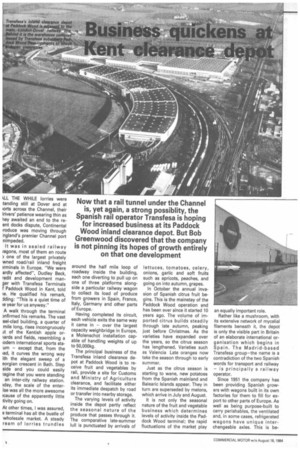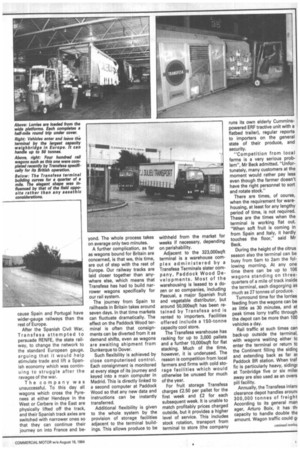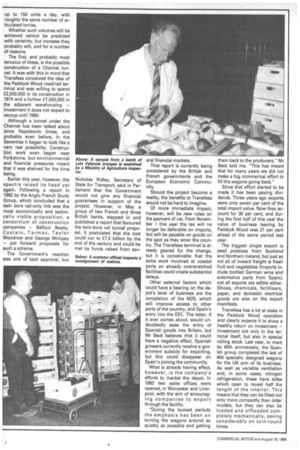Now that a rail tunnel under the Channel is, yet
Page 32

Page 33

Page 34

If you've noticed an error in this article please click here to report it so we can fix it.
again, a strong possiblity, the Spanish rail operator Transfesa is hoping for increased business at its Paddock Wood inland clearance depot. But Bob Greenwood discovered that the company is not pinning its hopes of growth entirely on that one development
1LL THE WHILE lorries were tanding still at Dover and at lofts across the Channel, their 'rivers' patience wearing thin as ney awaited an end to the reent docks dispute, Continental ■ roduce was moving through ngland's premier Channel port nimpeded.
It was in sealed railway iagons, most of them en route ) one of the largest privately wned road/rail inland freight ?rminals in Europe. "We were ardly affected", Dudley Beck, redit and development manger with Transfesa Terminals I Paddock Wood in Kent, told le. He qualified his remark, Ming: "This is a quiet time of le year for us anyway."
A walk through the terminal )nfirmed his remarks. The vast eel-clad building, a quarter of mile long, rises incongruously Lit of the Kentish apple orlards and fields, resembling a rodern international sports staurn — except that, from the lad, it curves the wrong way ith the elegant sweep of a eorgian crescent in Bath. Step side and you could easily lagine that you were standing an inter-city railway station. )(lay, the scale of the enterise was all the more awesome 'cause of the apparently little tivity going on.
At other times, I was assured, a terminal has all the bustle of wholesale market. A steady ream of lorries trundles around the half mile loop of roadway inside the building, each one diverting to pull up on one of three platforms alongside a particular railway wagon to collect its load of produce from growers in Spain, France, Italy, Germany and other parts of Europe.
Having completed its circuit, each vehicle exits the same way it came in — over the largest capacity weighbridge in Europe, a Molenschot installation capable of handling weights of up to 50,000kg.
The principal business of the Transfesa inland clearance depot at Paddock Wood is to receive fruit and vegetables by rail, provide a site for Customs and Ministry of Agriculture clearance, and facilitate either its immediate despatch by road or transfer into nearby storage.
The varying levels of activity inside the depot partly reflect the seasonal nature of the produce that passes through it. The comparative late-summer lull is punctuated by arrivals of lettuces, tomatoes, celery, onions, garlic and soft fruits such as apricots, peaches, and going on into autumn, grapes.
In October the annual invasion of Spanish citrus fruit begins. This is the mainstay of the Paddock Wood operation and has been ever since it started 10 years ago. The volume of imported citrus builds steadily through late autumn, peaking just before Christmas. As the varieties have expanded over the years, so the citrus season has lengthened. Varieties such as Valencia Late oranges now take the season through to early summer.
Just as the citrus season is starting to wane, new potatoes from the Spanish mainland and Balearic Islands appear. They in turn are superseded by melons, which arrive in July and August.
It is not only the seasonal nature of the fruit and vegetable business which determines levels of activity inside the Paddock Wood terminal; the rapid fluctuations of the market play an equally important role.
Rather like a mushroom, with its extensive network of mycelial filaments beneath it, the depot is only the visible part in Britain of an elaborate international organisation which begins in Spain. The Madrid-based Transfesa group—the name is a contradiction of the two Spanish words for transport and railway — is principally a railway operator.
Since 1951 the company has been providing Spanish growers with wagons built in its own factories for them to fill for export to other parts of Europe. As well as being purpose-built to carry perishables, the ventilated and, in some cases, refrigerated wagons have unique interchangeable axles. This is be cause Spain and Portugal have wider-gauge railways than the rest of Europe.
After the Spanish Civil War, Transfesa attempted to persuade RENFE, the state railway, to change the network to the standard European gauge, arguing that it would help stimulate trade and lift a Spanish economy which was continuing to struggle after the ravages of the war.
The company was unsuccessful. To this day all wagons which cross the Pyrenees at either Hendaye in the West or Cerbere in the East are physically lifted off the track, and their Spanish track axles are switched with narrower ones so that they can continue their journey on into France and be
yond. The whole process takes on average only two minutes.
A further complication, as far as wagons bound for Britain are concerned, is that we, this time, are out of step with the rest of Europe. Our railway tracks are laid closer together than anywhere else, which means that Transfesa has had to build narrower wagons specifically for our rail system.
The journey from Spain to railheads in Britain takes around seven days. In that time markets can fluctuate dramatically. The effect on the Paddock Wood terminal is often that consignments can be diverted from it as demand shifts, even as wagons are awaiting shipment from Dunkerque to Dover.
Such flexibility is achieved by close computerised control. Each consignment is monitored at every stage of its journey and keyed into a main computer in Madrid. This is directly linked to a second computer at Paddock Wood so that any new data and instructions can be instantly transferred.
Additional flexibility is given to the whole system by the provision of storage facilities adjacent to the terminal buildings. This allows produce to be withheld from the market for weeks if necessary, depending on perishability.
Adjacent to the 323,000sqft terminal is a warehouse complex administered by a Transfesa Terminals sister company, Paddock Wood Developments. Most of the warehousing is leased to a dozen or so companies, including Pascual, a major Spanish fruit and vegetable distributor, but around 50,000sqft has been retained by Transfesa and is rented to importers. Facilities offered include a 150-tonne capacity cool store.
The Transfesa warehouse has racking for up to 3,000 pallets and a further 10,000sqft for flat stacking. Much of the time, however, it is underused. The reason is competition from local farmers and firms with cold storage facilities which would otherwise be unused for much of the year.
For fruit storage Transfesa charges £2.50 per pallet for the first week and E2 for each subsequent week. It is unable to match profitably prices charged outside, but it provides a higher level of service. This includes stock rotation, transport from terminal to store (the company runs its own elderly Cumminspowered ERF tractive unit with a flatbed trailer), regular reports to importers on the general state of their produce, and security.
"Competition from local farms is a very serious problem", Mr Beck admitted. "Unfortunately, many customers at the moment would rather pay less even though the farmer doesn't have the right personnel to sort and rotate stock."
There are times, of course, when the requirement for warehousing, at least for any lengthy period of time, is not required. These are the times when the terminal is working flat out. "When soft fruit is coming in from Spain and Italy, it hardly touches the floor," said Mr Beck.
During the height of the citrus season also the terminal can be busy from 5am to 2am the following morning. At any one time there can be up to 106 wagons standing on threequarters of a mile of track inside the terminal, each disgorging as much as 27 tonnes of produce.
Turnround time for the lorries feeding from the wagons can be as little as 30 minutes, and at peak times lorry traffic through the depot can be more than 100 vehicles a day.
Rail traffic at such times can back-up outside the terminal, with wagons waiting either to enter the terminal or return tc the Continent filling the sidinc and extending back as far w.
Paddock BR station. When traf fic is particularly heavy, siding: at Tonbridge five or six mile: away are also used as an overs pill facility.
Annually, the Transfesa inlant clearance depot handles arounc 300,000 tonnes of freight
According to its general man ager, Arturo Boix, it has th,
capacity to handle double tha amount. Wagon traffic could g, up to 150 units a day, with roughly the same number of articulated lorries.
Whether such volumes will be achieved cannot be predicted with certainty, but increase they probably will, and for a number of reasons.
The first, and probably most tenuous of these, is the possible construction of a Channel tunnel. It was with this in mind that Transfesa conceived the idea of the Paddock Wood road/rail terminal and was willing to spend £2,500,000 in its construction in 1974 and a further £7,500,000 in the adjacent warehousing — investment it does not expect to recoup until 1990.
Although a tunnel under the Channel has been talked about since Napoleonic times, and probably even before, in the Seventies it began to look like a very real possibility. Construction work even began near Folkstone, but environmental and financial pressures meant that it was shelved for the time being.
Earlier this year, however, the spectre raised its head yet again. Following a report in 1982 by the Anglo French Study Group, which concluded that a twin bore rail-only link was the most economically and technically viable proposition, a consortium of construction companies — Balfour Beatty, Costain, Tarmac, Taylor Woodrow and George Wimpey — put forward proposals for such a scheme.
The Government's reaction was one of tacit approval, but Nicholas Ridley, Secretary of State for Transport, said in Parliament that the Government would not give any financial guarantees in support of the project. However, in May a group of two French and three British banks, stepped in and published a report that favoured the twin-bore rail tunnel proposal. It postulated that the cost could run to £7.5 billion by the end of the century and could be met by funds raised from sev eral financial markets.
That report is currently being considered by the British and French governments and the European Economic Community.
Should the project become a reality, the benefits to Transfesa would not be hard to imagine.
Of more immediate impact, however, will be new rules on the payment of vat. From November 1 this year the tax will no longer be deferable on imports, but will be payable on goods on the spot as they enter the country. The Transfesa terminal is already geared for the change, but it is conceivable that the extra work involved at coastal ports on already overstretched facilities could create substantial delays.
Other external factors which could have a bearing on the depot's level of business are the completion of the M25, which will improve access to other parts of the country, and Spain's entry into the EEC. The latter, if it ever comes about, would undoubtedly ease the entry of Spanish goods into Britain, but Mr Beck believes that it could have a negative effect. Spanish growers currently receive a government subsidy for exporting, but this could disappear on Spain's joining the community.
What is already having effect, however, is the company's efforts to market the depot. In 1982 two sales offices were opened, in Worcester and Liverpool, with the aim of encouraging companies to export through the facility.
"During the busiest periods the emphasis has been on turning the wagons around as quickly as possible and getting them back to the producers," Mr Beck told me. "This has meant that for many years we did not make a big commerical effort to fill the wagons going back."
Since that effort started to be made it has been paying dividends. Three years ago exports were only seven per cent of the total import value. Now they account for 30 per cent, and during the first half of this year the value of business leaving by Paddock Wood was 21 per cent ahead of the same period last year.
The biggest single export is seed potatoes from Scotland and Northern Ireland, but just as not all of inward freight is fresh fruit and vegetables (imports include bottled German wine and automotive parts from Spain), not all exports are edible either. Shoes, chemicals, fertilisers, paper, and domestic electrical goods are also on the export manifests.
Transfesa has a lot at stake in the Paddock Wood operation and clearly expects it to show a healthy return on investment — investment not only in the terminal itself, but also in special rolling stock. Last year, to mark its 40th anniversary, the Spanish group completed the last of 400 specially designed wagons for the UK arm of its business. As well as variable ventilation and, in some cases, nitrogen refrigeration, these have sides which open to reveal half the length of the interior. This means that they can be filled not only more compactly than older models, but they can also be loaded and offloaded completely mechanically, saving considerably on turn-round times.








































































